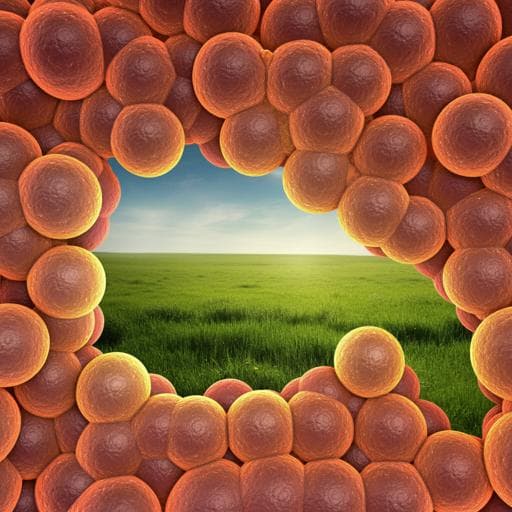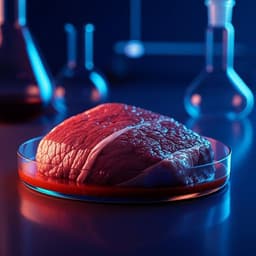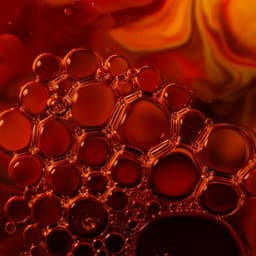
Food Science and Technology
Simple and effective serum-free medium for sustained expansion of bovine satellite cells for cell cultured meat
A. J. Stout, A. B. Mirliani, et al.
Explore how researchers Andrew J. Stout, Addison B. Mirliani, Miriam L. Rittenberg, Michelle Shub, Eugene C. White, John S. K. Yuen Jr., and David L. Kaplan are transforming the future of food with their innovative serum-free medium, Beefy-9, designed for long-term expansion of bovine satellite cells. This groundbreaking study promises to accelerate cultured meat research and pave the way for sustainable food systems.
~3 min • Beginner • English
Introduction
The study addresses a critical bottleneck in cultured meat R&D: the absence of affordable, food-safe, serum-free media that can sustain robust expansion of meat-relevant muscle satellite cells over multiple passages while maintaining myogenicity. Conventional culture relies on fetal bovine serum (FBS), which is costly, variable, unsustainable, and contrary to the goals of cultured meat. Prior serum-free formulations for satellite cells have been complex, less effective than serum-based media, reliant on proprietary or animal-derived components, or include potentially problematic additives. No serum-free medium had been validated for sustained satellite cell expansion over multiple passages. The authors hypothesize that the simple, low-cost iPSC medium B8 can be adapted for bovine satellite cells (BSCs) by targeted supplementation, specifically with recombinant human albumin, to yield a fully animal-component-free system supporting sustained expansion and preserved myogenicity. The objectives are to: (1) adapt B8 to create Beefy-9 by adding a single component; (2) establish a practical passaging protocol; (3) explore cost reduction (e.g., reduced FGF-2); (4) validate long-term expansion and myogenicity; and (5) optimize performance/cost by tuning albumin concentration (Beefy-9+).
Literature Review
The paper situates its work within efforts to replace FBS for satellite cell culture. Prior serum-free attempts were often complex, less effective than serum-containing media, used proprietary or animal-derived additives, or included components with regulatory concerns. Recent work on B8, a simple, chemically defined, low-cost medium for human iPSCs, demonstrated feasibility of low-cost growth factor production and potential food-safe component sourcing. Typical serum-containing or commercial serum-free media explored for satellite cells are substantially more expensive (~$200–$500/L) than in-house B8 (~$16/L with in-house growth factors). The authors leverage B8’s simplicity and cost as a foundation for a serum-free satellite cell medium. They also reference work on satellite cell biology, adhesion factors (laminin, vitronectin), and albumin’s multifaceted roles in media (carrier, antioxidant, stabilizer), as well as prior observations on growth kinetics, differentiation markers, and potential metabolic issues like lipid accumulation associated with insulin levels.
Methodology
Primary bovine satellite cells (BSCs) were isolated from semitendinosus muscle of a 14-day-old calf via collagenase II digestion, filtration, and pre-plating enrichment, followed by culture on laminin-coated plastic in growth medium (DMEM+GlutaMAX, 20% FBS, 1 ng/mL FGF-2, antibiotics). Identity was confirmed by Pax7 immunostaining (>96% Pax7+), and myogenicity by differentiation with MHC staining.
Short-term growth assays: Homemade B8 and supplier HiDef-B8 were prepared per published formulations. BSCs (passage <2) were seeded on laminin-511-coated plates (0.25 µg/cm²), allowed to adhere overnight in serum-containing medium, then switched to B8 variants and mixtures with serum media for 3–4 day proliferation assays. Supplements (e.g., IL-6, curcumin, recombinant human albumin, PDGF-BB, linoleic and oleic acids) were screened across concentrations. Cell number was quantified via dsDNA (FluoReporter), with statistical analysis by one-/two-way ANOVA and Tukey’s post-hoc tests.
Passaging protocol development: Initial passaging directly into Beefy-9 (B8 + recombinant albumin) impaired adhesion. Two strategies were tested: (1) omit rAlbumin for 24 h post-seeding (delayed rAlbumin) and (2) evaluate coatings: iMatrix-511 laminin, truncated vitronectin (Vtn-N), poly-D-lysine (PDL), and combinations. Adhesion and growth were quantified (PrestoBlue, live-cell imaging). Optimal conditions identified were seeding in B8 without rAlbumin onto 1.5 µg/cm² Vtn-N, adding rAlbumin the next day.
Serum-free differentiation: Cells expanded in Beefy-9 were differentiated for 4–6 days in a published serum-free differentiation medium (Neurobasal:L15 1:1 + IGF-1, EGF) and stained for MHC and other markers.
FGF-2 reduction: Short-term proliferation in B8 and Beefy-9 was tested across FGF-2 concentrations (0–80 ng/mL) to identify minimal effective doses.
Long-term expansion: BSCs were expanded over 28 days through seven passages in BSC-GM (serum), B8, Beefy-9 with 40 or 5 ng/mL FGF-2, and later Beefy-9 variants with higher rAlbumin (0.8, 1.6, 3.2, 6.4 mg/mL) and HiDef Beefy-9. Cells were seeded at standardized densities with appropriate coatings (iMatrix-511 for serum; Vtn-N for serum-free), with delayed rAlbumin addition for Beefy-9. Cell counts per passage enabled calculation of cumulative doublings and doubling times (nonlinear regression). Pax7, MyoD, Myogenin, and MHC were analyzed via immunostaining and qPCR (2^-ΔCt normalized to 18S). Lipid accumulation was assessed by BODIPY staining.
Cost analysis: Media component costs were compiled for small-scale and bulk purchasing, including scenarios with varied rAlbumin and FGF-2, and compared to BSC-GM. Performance/cost tradeoffs were evaluated.
Statistics: ANOVA with Tukey’s HSD for multiple comparisons; nonlinear regression for growth/doubling times; significance at p<0.05. Replicates included multiple biological and technical replicates as specified.
Key Findings
- B8 reduces but does not eliminate serum requirements for short-term BSC growth; B8 alone supports growth to day 3 but not day 4.
- Supplement screening identified six enhancers vs B8: IL-6, curcumin, recombinant human albumin (rAlbumin), PDGF-BB, linoleic acid, and oleic acid. rAlbumin was most effective (~4-fold improvement over B8 alone). Combinations did not significantly outperform rAlbumin alone.
- Beefy-9 (B8 + 800 µg/mL rAlbumin) enabled short-term proliferation comparable to serum-containing growth medium and maintained morphology.
- Passaging requires seeding without rAlbumin (delayed addition at 24 h) and coating with 1.5 µg/cm² truncated vitronectin (Vtn-N) for optimal adhesion and growth; laminin-511 was inferior under these conditions.
- Serum-free differentiation after expansion in Beefy-9 produced MHC+ multinucleated myotubes, confirming preserved myogenicity.
- FGF-2 concentration can be reduced without short-term growth penalty: to 5 ng/mL in B8 and 1.25 ng/mL in Beefy-9; complete removal impaired morphology and growth.
- Long-term expansion (28 days, 7 passages):
• B8 alone ceased proliferation after 3 passages (4.4 doublings).
• Beefy-9 sustained exponential growth for at least 7 passages: 18.2 doublings (40 ng/mL FGF-2) and 17.2 doublings (5 ng/mL FGF-2). Average doubling times ~39 h (high FGF-2) and ~41 h (low FGF-2). Doubling times remained <48 h through 5 passages (~13.7 doublings) and <56 h across all 7 passages.
• BSC-GM outperformed serum-free media over the month-long expansion.
- Stemness maintained: >96% Pax7+ nuclei across at least six passages in both BSC-GM and Beefy-9; qPCR for Pax3 and MyoD largely similar between media (transiently higher MyoD at P2 in Beefy-9).
- Increased lipid accumulation observed in serum-free conditions vs BSC-GM at later passages, potentially linked to high insulin or adipogenic shift.
- Cost analysis: At small scale, Beefy-9 (40 ng/mL FGF-2) ~$217/L vs BSC-GM ~$290/L; with 5 ng/mL FGF-2, Beefy-9 ~$189/L. Bulk purchasing reduces Beefy-9 to ~$74/L (high FGF) or ~$46/L (low FGF). rAlbumin and FGF-2 are major cost drivers; adhesion protein (Vtn-N) adds significant vessel cost (~$0.18/cm²).
- Raising rAlbumin increases growth: Short-term, up to 11.2 mg/mL gave an 8.5-fold improvement vs 0.8 mg/mL. Long-term, 3.2 and 6.4 mg/mL rAlbumin yielded ~19.8 and 20.2 doublings, with 3–4× final cell counts at day 28 relative to 0.8 mg/mL. Performance/cost best at 3.2 mg/mL (Beefy-9+, ~$148/L). HiDef Beefy-9 (engineered growth factors) doubled cell yield vs standard Beefy-9. Despite improvements, BSC-GM still achieved ~100-fold higher yield than serum-free media over seven passages.
Discussion
The work demonstrates that a simple augmentation of the B8 medium with recombinant human albumin creates Beefy-9, a fully animal-component-free medium capable of sustaining bovine satellite cell proliferation over multiple passages while preserving myogenic potential. Albumin’s roles as a carrier and antioxidant likely stabilize key media constituents and mitigate deleterious reactions, explaining the marked benefit for BSCs compared to its modest effect in iPSC culture. The optimized passaging protocol—seeding without albumin and using truncated vitronectin coating—overcomes adhesion deficits in serum-free conditions. Long-term data show sustained expansion, acceptable doubling times, and maintained stemness and differentiation capacity, addressing the core challenge of serum-free expansion. Nonetheless, proliferation remains slower than in serum, and lipid accumulation occurs over time, indicating metabolic tuning (e.g., insulin and fatty acids) may be necessary. Cost analyses indicate Beefy-9/Beefy-9+ are more economical than serum-containing media for research use, especially with bulk purchasing and reduced FGF-2, although recombinant proteins and adhesion substrates remain major cost drivers. Engineered growth factors and increased albumin (Beefy-9+) improve performance, with 3.2 mg/mL offering a favorable performance/cost balance. Overall, the results provide a practical foundation for serum-free cultured meat research and a platform for iterative optimization toward industrial viability.
Conclusion
This study introduces Beefy-9, a simple, serum- and animal-component-free medium based on B8 with added recombinant human albumin, that supports sustained expansion and preserved myogenicity of bovine satellite cells over at least seven passages. A robust passaging workflow using delayed albumin addition and vitronectin coating is established. Cost analyses show Beefy-9 is more economical than serum-containing media for research settings, with further reductions possible via lower FGF-2, bulk purchasing, and optimized albumin levels. Increasing albumin (Beefy-9+) enhances long-term yields, with 3.2 mg/mL providing a strong performance/cost ratio. Future work should focus on multifactorial (including computational) media optimization, reduction or substitution of costly recombinant components (albumin, growth factors), modulation of insulin/fatty acids to mitigate lipid accumulation, exploration of engineered thermally stable growth factors, evaluation across species and cell types, and strategies to reduce adhesion substrate costs or transition to alternative culture modalities (e.g., suspension, pre-coated or low-cost substrates).
Limitations
- Long-term proliferation in Beefy-9 remains slower than in serum-containing media, resulting in lower cumulative doublings and cell yields over seven passages.
- Aberrant lipid accumulation occurs in serum-free conditions at later passages, potentially reflecting insulin-driven metabolic effects or partial adipogenic shift.
- Adhesion in serum-free conditions requires high concentrations of recombinant vitronectin, adding significant cost and complexity.
- Media optimization used a one-factor-at-a-time approach; interactions between components may reveal superior formulations not tested here.
- Dependence on recombinant proteins (albumin, growth factors) is a major cost driver; industrial viability requires further cost reductions or substitutions.
- Complete removal of FGF-2 severely impairs growth and morphology, limiting flexibility.
- Generalizability to other species/cell types is suggested but not experimentally validated in this study.
- Some promising configurations (e.g., Beefy-9+ with reduced FGF-2) were not tested; engineered growth factor use was limited to supplier-provided comparisons (HiDef).
Related Publications
Explore these studies to deepen your understanding of the subject.







